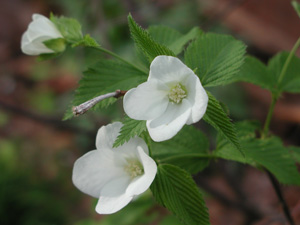Resource Library
Plant of the Week: Jetbead
The University of Arkansas System Division of Agriculture does not promote, support or recommend plants featured in "Plant of the Week." Please consult your local Extension office for plants suitable for your region.
Plant of the Week
Jetbead
Latin: Rhodotypos scandens

Perhaps it is some character flaw, but it seems to me we Americans have an obsession with the “best.” This is obviously short sighted, because few who seek out the “best” would themselves qualify for that lofty position. Jetbead (Rhodotypos scandens) will never be found on anybody’s list of best plants but it is tough and dependable, and surely that must count for something.
Jetbead is a wispy deciduous shrub of the rose family that grows 3 to 6 feet tall with a mounded habit. In general form it has a vague resemblance to the yellow-flowered Kerria japonica, another member of the rose family, where it was once classified until being separated out as a monotypic, or “only one,” species. Though the species epitaph indicates the plant is climbing, it is not, but instead spreads by sprawling about and producing basal suckers.
The opposite, ovate 3-to 4-inch long leaves have coarsely serrate margins and come to a sharp point. In the spring the leaves are a bright green that give a modest yellow fall color display when fall arrives. White, four-petaled flowers to 2 inches in diameter appear with the foliage in late spring at the ends of branches. Hard black, shiny berries about the size of a peanut are produced in clusters of 3 or 4 in the fall and persist through the winter, apparently because there is no pulp to entice birds.
The ornamental display created by jetbead is modest at best, though the plant did gain widespread use during the Victorian period when new and exotic were merit enough to warrant planting. Because the flowers appear late in the spring and are interesting only on close inspection, they don’t compete well with more floriferous competition. And while black berries are a good choice if you’re into the Goth look, they don’t stand out in the winter landscape.
Jetbead is native to China, Korea and Japan, from where it was introduced into the United States in 1866 by physician-turned-oriental trader George Robert Hall of Bristol, R.I., who was responsible for introducing a number of now-common Japanese plants including Japanese maple and Japanese honeysuckle. Jetbead was first described in 1794 by Carl Thunberg, a student of Linnaeus who wrote the first flora describing Japanese plants. It was given its current genus name by another famous Japanese traveler, Philipp von Siebold in 1841when he introduced it to his nursery in Netherlands.
Jetbead grows on steep slopes in partial shade in its native range in China and Korea (it may have been introduced into Japan as an ornamental). In the garden it seems to do best in similar situations where it is partially shaded by high-canopy trees. It tolerates dry shade well but will also grow in full sun. If conditions get too dry, the foliage will become tattered during prolonged periods of drought stress. Its best use in the landscape is as a background plant or as a tall groundcover on steep banks or other hard-to-maintain locations.
This plant has escaped in some of the Northeastern states and is considered an invasive. It has the potential to spread into the forest understory where it could compete with native shrubs.
By: Gerald Klingaman, retired
Retired Extension Horticulturist - Ornamentals
Extension News - September 6, 2012
The University of Arkansas System Division of Agriculture does not maintain lists of retail outlets where these plants can be purchased. Please check your local nursery or other retail outlets to ask about the availability of these plants for your growing area.